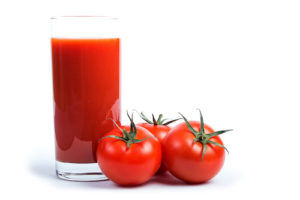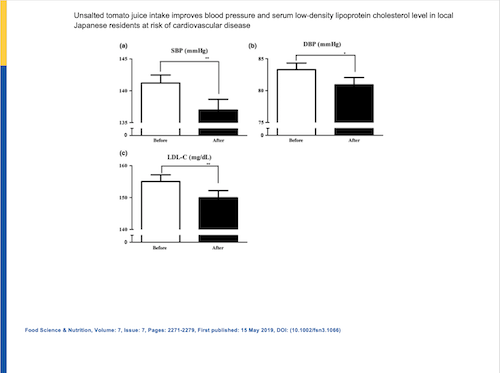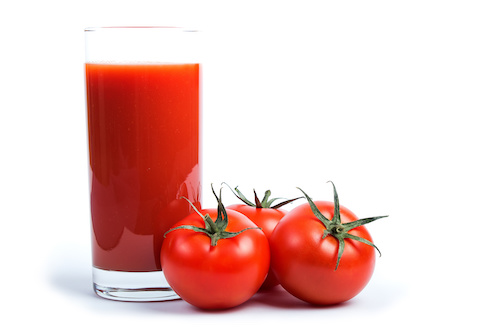Could tomato juice be your next patient recommendation? Chronic  endothelial injury from hypertension, dyslipidemia, and diabetes are important contributors of atherosclerosis progression in aging populations. This means it is important to find easy ways to regulate patient blood pressure (BP), and lipid and glucose metabolism, to prevent the development of cardiovascular disease. One way may be consumption of unsalted tomato juice. It’s affordable, easy to find and tastes pretty good.
endothelial injury from hypertension, dyslipidemia, and diabetes are important contributors of atherosclerosis progression in aging populations. This means it is important to find easy ways to regulate patient blood pressure (BP), and lipid and glucose metabolism, to prevent the development of cardiovascular disease. One way may be consumption of unsalted tomato juice. It’s affordable, easy to find and tastes pretty good.
A new study from Japan, published in Food Science and Nutrition, recruited 541 residents, of which 481 completed the study. Participants were given as much tomato juice as they liked.
Researchers collected participants’ food diaries every 3 months and calculated overall tomato juice consumption and total days of tomato juice intake throughout the study period (one year) based on the diaries. They then calculated the frequency of tomato juice intake and the average tomato juice consumption per day across the entire cohort.
Among all participants, the frequency of daily unsalted tomato juice intake throughout the study period was 92.0 ± 12.2%, and the average daily tomato juice consumption was 215 ± 84 ml. Most of the study participants consumed about 1 bottle (200 ml) of unsalted tomato juice every day. The study found:
- The mean systolic blood pressure (SBP)and diastolic blood pressure (DBP) were significantly lowered after a year of tomato juice intake (SBP, 141.2 ± 12.1–137.0 ± 16.3 mmHg, p = 0.003; DBP, 83.3 ± 10.1–80.9 ± 11.1 mmHg, p = 0.012, paired t test);
- In 127 participants with untreated dyslipidemia, the mean serum TG and HDL‐C level did not change significantly after a year of tomato juice consumption (TG, 130.3 ± 69.6–136.8 ± 84.2 mg/dl, p = 0.255; HDL‐C, 63.0 ± 17.3–61.6 ± 16.6 mg/dl, p = 0.051),
- whereas the mean serum LDL‐C level was significantly decreased (155.0 ± 23.2–149.9 ± 25.0 mg/dl, p = 0.005, paired t test).
- There were no significant differences in the mean changes in SBP, DBP, and serum LDL‐C level between the sexes, age or lifestyle among the groups.
“To the best of our knowledge, the current study is the first to investigate the effects of tomato or tomato product intake on CVD risk markers over the course of a year and over a wide age range.” ~ research team
FIGURE 1

The researchers note that tomatoes contain a number of bioactive components that are beneficial for health, including lycopene, esculeoside A and peroxisome proliferator‐activated receptors (PPARs).
Studies on lycopene show:
- Strong antioxidant activity;
- Inhibits LDL oxidation;
- Regulates of cholesterol metabolism through the suppression of cholesterol synthesis and efflux in macrophages;
- Reduces the production of proinflammatory cytokines through activation of peroxisome proliferator‐activated receptor γ and inhibition of nuclear factor‐κB;
Studies on Esculeoside A show:
- The tomato saponin has protective effects on dyslipidemia and atherosclerosis development by inhibiting cholesterol acyltransferas (ACAT);
- The inhibition of ACAT decreases the absorption of diet‐derived cholesterol in the small intestine, macrophage foam cell formation, and cholesterol synthesis in the liver;
- Suppresses the activity of ACAT, reduces the serum levels of TG, LDL‐C, and total cholesterol, and improves atherosclerotic lesions in apolipoprotein E‐deficient mice.
Studies on PPARs show:
- Three subtypes have been identified (α, β, γ) that regulate energy homeostasis, including lipid and glucose metabolism;
- Activation of PPARα results in enhancement of fatty acid oxidation and improvement of dyslipidemia;
- PPARα stimulation induces antioxidant activity, leading to improvement in the activity of endothelial factors that control blood pressure, cardiac function and neuroprotective effects against cerebral injury.
The researchers note a few limitations. Most of the study participants consumed about one bottle of tomato juice (200 ml) every day, however, they could not evaluate whether the effects of tomato juice on CVD risk markers depended on the level of consumption. Also, detailed information of the diet each participant followed during the study period is lacking, including intake of other juices and nutritional supplements. Finally, the study on lifestyle factors was conducted in only about half of the participants and the findings may not be applicable to the whole study population.
Conclusion/ “Unsalted tomato juice intake could have improved systolic and diastolic blood pressure in Japanese residents who had untreated prehypertension or hypertension, and also decreased the serum LDL‐C level in those who had untreated dyslipidemia. As tomato juice is an affordable and readily product, it could be practical as applied a nutritional intervention to prevent CVDs in people at risk.”





